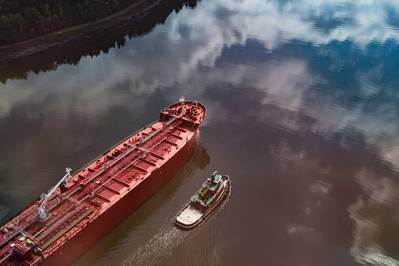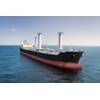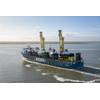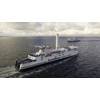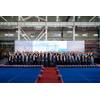Propulsion Decisions or Smoke on The Water?
In no uncertain terms, the goal of “future capable” ship’s propulsion is confusing. We have been pressed into a regulatory environment that asks us to reduce emissions, and in the same breath deliver power sufficient to meet commercial schedules and allow the vessel to weather a storm and be safe at sea. To reach that end, owners are presented with a basket of new alternative fuels to achieve the latest January 1, 2023 Carbon Intensity Indicator (CII) regulations. Add that most operators have no previous historical experience or data with these alternative fuels, nor has industry developed the infrastructure necessary to make the fuels available at most, if not all, of the ports we trade in.
This is not a new issue. The discussions concerning reducing energy use, engine “derating” and reducing ship speed reaches back to the “ECO” ship debates decades ago. The “emissions” discussions and speed reduction were the avenue to reduce CO2. Those who took part in the ECO debate argued that the reduction of power to reach the IMO proposals placed the vessels in jeopardy at sea. Others looked at the commercial benefit with regard to the supply and demand imbalance. Operators knew that the main engines were not designed to operate for long periods at lower output levels.
Most of the current operating tonnage delivered with an Energy Efficiency Design Index (EEDI) calculation are looking at how their Energy Efficiency Existing Ship Index (EEXI) calculation and their CII rating will fare in 2023. A MARPOL Annex VI requirement, the CII basically measures/calculates the efficiency of a ship in transporting cargo or passengers in terms of its CO2 emissions per nautical mile and carrying capacity.
CII determines the annual reduction needed to ensure continuous improvement of a ship’s operation within a specific rating level. Understand the factor of “per nautical mile” or the actual voyage itinerary severely impacts that calculation along with your rating and how you compare to your competition. Start advising your chartering department to plan LONG voyages.
Recent survey reports indicate older tonnage will require the installation of an “energy savings device”, their main engines derated and operating speeds reduced to meet the new emission reduction goals. The CII currently addresses actual tonnage on the water. What is important is the IMO 2030 requirement to reduce emissions by 40% is now only seven years away—a period that can be associated with recent declines in Far East shipbuilding. CII may reach beyond existing tonnage and into your building plans.
Overall, industry analysts reported that South Korean orders were down 28% during the second quarter of 2022. The Korean Export-Import Bank has projected a further decline of 42% for 2023. We can place blame on the global pandemic or the geopolitical environment affecting all freight markets. Take also into account the price of steel affecting construction costs and a supply chain debacle creating havoc with delivery of machinery and equipment—all solid reasons forcing a downturn to occur. That said, the upcoming seven-year period may see a further decline in one of the major shipbuilding countries in the world.
If you are making a decision to build in 2024, the decision process and specification review, coupled with a construction period of 10 to 12 months to delivery, results in your vessel delivery around 2026 or 2027. Five years later, during your first special survey, you will be required to meet a 40% reduction in greenhouse gas emissions as compared to 2008 levels. Your choice of engine, energy savings device and alternative fuel type must be made now, and these decisions are not easy. In fact, the downturn may be amplified by these difficulties. And as a result, many of the larger Korean yards and design houses are looking at carbon capture rather than alternative fuels, a means to continue with large two stroke engines burning existing fuel sources until such alternative fuel infrastructure can be developed.
CII is based directly on fuel consumption and is related to the ship’s technical efficiency and fuel. Operational parameters such as vessel speed, cargo transported, weather conditions and the general condition or maintenance of the vessel including hull fouling are also reviewed.
After nearly 45 years as a builder, owner and ship manager, it is our experience that the operational parameters listed above have always been the items analyzed by crew and technical shore staff on a nearly daily basis in order to confirm a safe, efficient and profitable ship operation. The same decision process is completed in ship construction. We have been through more than six “ECO” generations in the tanker market.
Hull designs and capacity have been improved. Engines have been further improved. Coating manufacturers have continued to develop hull applications to reduce fouling and in turn fuel consumption. We have even installed LED lighting not only to reduce energy but also save costs of constantly replacing incandescent bulbs. Many in the industry have reacted and addressed “emissions” without the need of a CII, and all of those actions have been within environmental compliance. Simply put, actions to maintain industry sustainability have been in place with the International Safety Management (ISM) Code.
ISM was adopted in 1994 as part of the SOLAS Convention to provide a means to confirm operators were meeting standards similar to CII. A controversial piece of legislation established to abolish substandard ships and operators with the inspections, surveys documents and ISM systems have been in place for nearly 30 years. With all of that survey and documentation, do we now need a CII to “rate” an operation? Has ISM failed us, or do EEXI and CII ratings lead to a financial model base rather than a safety and environmental one?
The term environment, sustainability and governance (ESG) has made its way into shipping from the investment community. It is a subjective rating system that evaluates a shipping company’s policies and operations based on conforming to a mix of parameters. In addition to the actual regulatory requirements in place, the mix is not consistent from one jurisdiction or evaluator to another. As with many other industries, reputations and competitiveness can be impacted by ratings defined as “leaders”, “average” and “laggard”.
In shipping, the number of companies obtaining ESG ratings is on the rise. In addition to the risks of making long-term capital commitments, the added costs and operational limitations that arise from ESG-driven requirements (all of which are rarely discussed by proponents) have resulted in further escalated risks, often negatively impacting investments. The reality is that ESG analysis or rating as an investment evaluation tool has not been very successful. Simply stated, hull design, propulsion technologies and fuel-choices that can actually be the basis for a very long-term investment such as a ship are not in clear view. Suffice to say your business success reaches far beyond environmental compliance with sustainability capability well beyond climate change emissions.
We have been working with a fund that has followed a different investment analysis: economic, sustainable and deployable (ESD). The environmental factor is analyzed in the sustainability goal, and the actual project or investment must be both economically justifiable and the technology deployable in a practical sense, leading to real long-term sustainability.
We will provide one simple ESG example on how the environmental requirements can affect the commercial viability. A recent shipping company that delivered liquefied natural gas (LNG) powered vessels to achieve better emissions performance returned to the shipyard to modify the engines back to dual fuel and marine diesel oil (MDO). The current price of LNG was prohibitive, and as a result, the operation was not sustainable or deployable based on the preferred environmental fuel choice.
The shipping industry represents only a 1.7% of global greenhouse gas emissions. There have been smart decisions and regulations. The development of the Emission Control Areas (ECA) directing sulfur and nitrous oxide reduction within population areas addressed all vessel types trading in the designated areas – foreign and domestic – large and small. The regulations not only provided sustainable technical directions but also led to forward thinking ship owners and engine manufacturers to look at hybrid, LNG and alternatives fuels in smaller engines and vessels. The regulation created a pilot platform that could be used to develop technical adjustment for the larger engines. The larger ships complied within the ECA and returned to lower sulfur heavy fuels outside the population area and as a result remained economically sustainable.
So why not continue chipping away at emissions sustainability within the same process to ensure commercial sustainability: smart regulations building on our current reporting requirements and standards?



